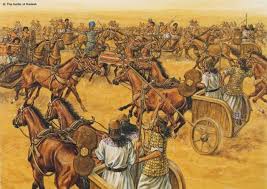The Ancient Egyptian Battles of the Delta was a great sea battle, fought between Egyptian forces and the so-called Sea People when the Egyptian Pharaoh Ramses III repulsed a great sea invasion by the ‘People of the Sea’.

The conflict occurred somewhere at the shores of the eastern Nile Delta and partly on the borders of the Egyptian Empire in Syria, although their precise location is unknown. This battle has been described as ‘the first naval battle in history’. This major conflict is recorded on the temple walls of the mortuary temple of Pharaoh Ramses III at Medinet Habu.
Historical background
The Nomadic warrior tribes of Tjekker, Peleset, Sherden, and others were collectively known as the Sea People. In the 12th century BC, they invaded the Middle East from the eastern Mediterranean, destroying and plundering the Hittite Empire along the way. They also attacked Syria and Palestine ruining and burning the cities as they went.
Cyprus was also overwhelmed and its capital ransacked. It was clear that they were almost desperate to find a place for inhabitation and Egypt seemed a perfect choice. The attack of the Sea Peoples was probably the greatest threat Ancient Egypt ever faced.
Ancient Egyptian Battles
After defeating the Sea Peoples on land in Syria, Ramses rushed back to Egypt where preparations for the invader’s assault had already completed. The inscriptions of Ramses III at his Medinet Habu mortuary temple in Thebes record this epic event in great detail. These Ancient Egyptian Battles were a turning point for the Pharaoh because the Egyptians had never had to fight a serious sea battle before.
Ramses reacted with great tactical brilliance; he lined the shores of the Nile Delta with ranks of archers who were ready to release volleys of arrows into the enemy ships if they attempted to land. Knowing that he would be defeated in the battle at sea, Ramses enticed the Sea Peoples and their ships into the mouth of the Nile, from where he struck his ambush.
He had assembled a fleet for this specific occasion. In an inspired tactical maneuver, the Egyptian fleet worked the Sea Peoples’ boats towards shore where the Egyptian archers, based on land, devastated the enemy with volley after volley of deadly arrows. Meanwhile, the Egyptian marine archers, calmly standing on the decks of their ships, fired in unison. Their ships were overturned, many were killed and captured and some even dragged to the shore where they were executed. Consequently, the Sea Peoples were defeated even when they were able to set foot on Egypt’s land.
Aftermath
While there is no documentation for any pursuit of the defeated Sea Peoples, who fled to the Levant, Egypt was saved from the fate of total destruction which befell Hatti, Alasiya, and other great Near Eastern powers. Ramses could certainly content himself with a great and decisive victory. Although he had defeated the Sea Peoples, some of them, specifically the Peleset, eventually settled in Canaan and Palestine after his death.
Every foreign power on the Mediterranean was destroyed in the face of the Sea Peoples’ onslaught; only the Egyptians were able to withstand their attack. However, this proved to be a pyrrhic victory, because, in the end, Egypt was so weakened by it that it never recovered to be the powerful kingdom it was prior to the Sea People’s invasion. Ramses III is generally considered to the last great Pharaoh of Egypt’s the New Kingdom. The conflict with the Sea Peoples also drained her treasury. Thus, the Egyptians used to say that death comes from across the seas.
